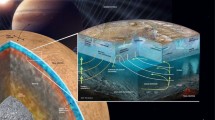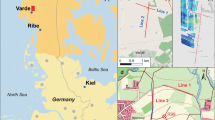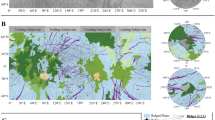Abstract
In this paper, aeromagnetic and gravity anomalies obtained from the General Directorate of Mineral Research and Exploration were subjected to upward continuation to 3 km from the ground surface to suppress shallow effects and to expose only regional, deep sources. Then, a reduction to pole (RTP) map of aeromagnetic anomalies was produced from the 3 km upward continued data. A sinuous boundary to the south of Turkey is observed in the RTP map that may indicate the suture zone between the Anatolides and African/Arabian Plates in the closure time of the Tethys Ocean. The sinuous boundary can be correlated with the recent palaeo-tectonic maps. The southern part of the sinuous boundary is quite different and less magnetic in comparison with the northern block. In addition, maxspots maps of the aeromagnetic and gravity anomalies were produced to find out and enhance the boundaries of tectonic units. Crustal thickness, recently calculated and mapped for the western Turkey, is also extended to the whole of Turkey, and the crustal thicknesses are correlated with the previous seismological findings and deep seismic sections. The average crustal thickness calculations using the gravity data are about 28 km along the coastal regions and increase up to 42 km through the Iranian border in the east of Turkey. Density and susceptibility values used as parameters for construction of two-dimensional (2D) gravity and magnetic models were compiled in a table from different localities of Turkey. 2D models indicate that all of the anomalous masses are located in the upper crust, and this could be well correlated with the earthquakes which occurred at shallow depths.











Similar content being viewed by others
References
Angus DA, Wilson DC, Sandvol E, Ni JF (2006) Lithospheric structure of the Arabian and Eurasian collision zone in eastern Turkey from S-wave receiver functions. Geophys J Int 166:1335–1346
Arslan S, Akin U, Alaca A (2010) Investigation of crustal structure of Turkey by means of gravity data. Mineral Res Expl Bull 140:55–71
Artemieva IM, Thybo H (2008) Deep Norden: highlights of the lithospheric structure of northern Europe, Iceland and Greenland. Episodes 31:98–106
Ates A, Kearey P (2000) Interpretation of gravity and aeromagnetic anomalies of the Konya region, South central Turkey. J Balkan Geophys Soc 3:37–44
Ates A, Kearey P, Tufan S (1999) New gravity and magnetic anomaly maps of Turkey. Geophys J Int 136:499–502
Ates A, Bilim F, Buyuksarac A (2005) Curie point depth investigation of central Anatolia, Turkey. Pure Appl Geophys 162:357–371
Ates A, Bilim F, Buyuksarac A, Bektas O (2008) A tectonic interpretation of the Marmara Sea, NW Turkey from geophysical data. Earth Planets Space 60:169–177
Ates A, Buyuksarac A, Bilim F, Bektas O, Sendur C, Komanovali G (2009) Spatial correlation of the aeromagnetic anomalies and seismogenic faults in the Marmara region, NW Turkey. Tectonophysics 478:135–142
Aydemir A (2008) Hydrocarbon potential of the Tuzgolu (Salt Lake) Basin, Central Anatolia, Turkey: a comparison of geophysical investigation results with the geochemical data. J Pet Sci Eng 61:33–47
Aydemir A (2009) Tectonic investigation of central Anatolia, Turkey using geophysical data. J Appl Geophys 68:321–334
Aydemir A (2011) An integrated geophysical investigation of Haymana Basin and hydrocarbon prospective Kirkkavak formation in Central Anatolia, Turkey. Petrol Geosci 17:91–100
Aydemir A, Ates A (2006a) Interpretation of Suluklu-Cihanbeyli-Goloren magnetic anomaly, Central Anatolia, Turkey: an integration of geophysical data. Phys Earth Planet Inter 159:167–182
Aydemir A, Ates A (2006b) Structural interpretation of the Tuzgolu and Haymana Basins, Central Anatolia, using seismic, gravity and aeromagnetic data. Earth Planets Space 58:951–961
Becel A, Laigle M, de Voogd B, Hirn A, Taymaz T, Galve A, Shimamura H, Murai Y, Lepine JC, Sapin M, Ozalaybey S (2009) Moho, crustal architecture and deep deformation under the North Marmara Trough, from the SEISMARMARA Leg 1 offshore-onshore reflection-refraction survey. Tectonophysics 467:1–21
Bektas O, Ravat D, Buyuksarac A, Bilim F, Ates A (2007) Regional geothermal characterization of East Anatolia from aeromagnetic, heat flow and gravity data. Pure Appl Geophys 164:975–998
Bilim F (2007) Investigations into the tectonic lineaments and thermal structure of Kutahya–Denizli region, western Anatolia, from using aeromagnetic, gravity and seismological data. Phys Earth Planet Inter 165:135–146
Bilim F (2011) Investigation of the Galatian volcanic complex in the northern central Turkey using potential field data. Phys Earth Planet Inter 185:36–43
Bilim F, Ates A (1999) A computer program to estimate the source body magnetization direction from magnetic and gravity anomalies. Comput Geosci 25:241–250
Bilim F, Ates A (2004) An enhanced method for estimation of body magnetization direction from pseudogravity and gravity data. Comput Geosci 30:161–171
Bilim F, Ates A (2007) Identifying block rotations from remanent magnetization effect: example from northern Central Anatolia. Earth Planets Space 59:33–38
Bingöl E (1989) 1/2,000,000 Scale Geological Map of Turkey, Publication of the Mineral Research and Exploration (MTA) of Turkey, Ankara
Biryol CB, Beck SL, Zandt G, Ozacar AA (2011) Segmented African lithosphere beneath the Anatolian region inferred from the teleseismic P-wave tomography. Geophys J Int 184:1037–1057
Blakely RJ (1996) Potential theory in gravity and magnetic applications. Cambridge University Press, UK
Blakely RJ, Simpson RW (1986) Approximating edges of source bodies from magnetic or gravity anomalies. Geophysics 51:1494–1498
Buyuksarac A (2007) Investigation into the regional wrench tectonics of inner East Anatolia (Turkey) using potential field data. Phys Earth Planet Inter 160:86–95
Buyuksarac A, Jordanova D, Ates A, Karloukovski V (2005) Interpretation of the gravity and magnetic anomalies of the Cappadocia region, Central Turkey. Pure Appl Geophys 162:2197–2213
Buyuksarac A, Taymaz T, Ates A, Bilim F, Aydemir A, Bektas O, Yolsal S, Cubuk Y (2009) Gravity anomalies and crustal structure of Turkey. In: Proceedings of international symposium on historical earthquakes and conservation of monuments and sites in the Eastern Mediterranean Region, 500th anniversary year of the 1509 September 10, Marmara Earthquake, 10–12 September 2009, Istanbul
Cakir O, Erduran M (2011) On the P and S receiver functions used for inverting the one-dimensional Upper Mantle shear-wave velocities. Surv Geophys 32:71–98
Demir D, Bilim F, Aydemir A, Ates A (2012) Modelling of Thrace Basin, NW Turkey using gravity and magnetic anomalies with control of seismic and borehole data. J Pet Sci Eng. doi:10.1016/j.petrol.2012.03.013
Dobrin MB, Savit CH (1988) Introduction to geophysical prospecting. McGraw-Hill, New York
Gans CR, Beck SL, Zandt G, Biryol CB, Ozacar AA (2009) Detecting the limit of slab break-off in central Turkey: new high-resolution Pn tomography results. Geophys J Int 179:1566–1572
Genc Y, Yurur MT (2010) Coeval extension and compression in Late Mesozoic-Recent thin-skinned extensional tectonics in Central Anatolia. J Struct Geol 32:623–640
Gok R, Pasyanos ME, Zor E (2007) Lithospheric structure of the continent–continent collision zone: eastern Turkey. Geophys J Int 169:1079–1088
Gursoy H, Piper JDA, Tatar O, Temiz H (1997) A palaeomagnetic study of the Sivas basin, Central Turkey: crustal deformation during lateral extrusion of the Anatolian Block. Tectonophysics 271:89–105
Gursoy H, Piper JDA, Tatar O, Mesci L (1998) Paleomagnetic study of the Karaman and Karapinar volcanic complexes, Central Turkey, Neotectonic rotation in the South-central sector of the Arabian Block. Tectonophysics 299:191–211
Kearey P (1991) A possible source of the south-central England magnetic anomaly, basaltic rocks beneath the London Platform. J Geol Soc London 148:775–780
Kearey P, Brooks M, Hill I (2002) An introduction to exploration geophysics. Blackwell, UK
Kearey P, Klepeis KA, Vine FJ (2009) Global tectonics, 3rd edn. Blackwell, UK
McClusky S, Balassanian S, Barka A, Demir C, Ergintav S, Georgiev I, Gurkan O, Hamburger M, Hurst K, Kahle H, Kastens K, Kekelidze G, King R, Kotzev V, Lenk O, Mahmoud S, Mishin A, Nadariya M, Ouzounis A, Paradissis D, Peter Y, Prilepin M, Reilinger R, Sanli I, Seeger H, Tealeb A, Toksoz MN, Veis G (2000) Global positioning system constraints on plate kinematics and dynamics in the Eastern Mediterranean and Caucasus. J Geophys Res 105:5695–5719
Moix P, Beccaletto L, Kozur HW, Hochard C, Rosselet F, Stampfli GM (2008) A new classification of the Turkish terranes and sutures and its implication for the paleotectonic history of the region. Tectonophysics 451:7–39
Necioglu A, Maddison B, Turkelli N (1981) A study of crustal and upper mantle structure of northwestern Turkey. Geophys Res Lett 8:33–35
Neev D, Hall JK, Saul JM (1982) The Pelusium Megashear system across Africa and associated lineament swarms. J Geophys Res 87:1015–1030
Onal KM, Buyuksarac A, Aydemir A, Ates A (2008) Investigation of the deep structure of the Sivas basin (innereast Anatolia, Turkey) with geophysical methods. Tectonophysics 460:186–197
Ozturk F (1997) Investigations into magnetic and gravity anomalies of the region between Kirikkale and Tuz Lake. MSc Thesis, Ankara University, Turkey (unpublished) (in Turkish with English abstract)
Piper JDA, Gursoy H, Tatar O, Beck ME, Rao A, Kocbulut F, Mesci BL (2010) Distributed neotectonic deformation in the Anatolides of Turkey: a palaeomagnetic analysis. Tectonophysics 488:31–50
Reilinger R, McClusky S, Vernant P, Lawrence S, Ergintav S, Cakmak R, Ozener H, Kadirov F, Guliev I, Stepanyan R, Nadariya M, Hahubia G, Mahmoud S, Sakr K, ArRajehi A, Paradissis D, Al-Aydrus A, Prilepin M, Guseva T, Evren E, Dmitrotsa A, Filikov SV, Gomez F, Al-Ghazzi R, Karam G (2006) GPS constraints on continental deformation in the Africa-Arabia-Eurasia continental collision zone and implications for the dynamics of plate interactions. J Geophys Res 111:B05411
Riad S, El Etr HA (1985) Bouguer anomalies and lithosphere-crustal thickness in Uganda. J Geodyn 3:169–186
Riad S, Refai E, Ghalib M (1981) Bouguer anomalies and crustal structure in the Eastern Mediterranean. Tectonophysics 71:253–266
Rivero L, Pinto V, Casas A (2002) Moho depth structure of the eastern part of the Pyrenean belt derived from the gravity data. J Geodyn 33:315–332
Saunders P, Priestley K, Taymaz T (1998) Variations in the crustal structure beneath western Turkey. Geophys J Int 134:373–389
Sengor AMC, Yilmaz Y (1981) Tethyan evolution of Turkey: a plate tectonic approach. Tectonophysics 75:181–241
Spector A, Grant FS (1970) Statistical models for interpreting aeromagnetic data. Geophysics 35:293–302
Storetvedt KM (1990) The Tethys Sea and the Alpine-Himalayan orogenic bels; mega-elements in a new global tectonic system. Phys Earth Planet Inter 62:141–184
Storetvedt KM (2003) Global wrench tectonics. Fagbokforlaget, Norway
Storetvedt KM, Longhinos B (2011) Evolution of the north Atlantic: paradigm shift in the offing. New Concepts Glob Tectonics Newsl 51:9–48
Telford WM, Geldart LP, Sheriff RE (1990) Applied geophysics, 2nd edn. Cambridge University Press, Cambridge
Tezel T, Erduran M, Alptekin O (2007) Crustal shear wave velocity structure of Turkey by surface wave dispersion analysis. Ann Geophys 50:177–190
Tezel T, Shibutani T, Kaypak B (2010) Crustal structure variation in western Turkey inferred from receiver function analysis. Tectonophysics 492:240–252
Tirel C, Gueydan F, Tiberi C, Brun JP (2004) Aegean crustal thickness inferred from gravity inversion. Geodynamical implications. Earth Planet Sci Lett 228:267–280
Acknowledgments
Authors are grateful to the General Directorate of Mining Research and Exploration of Turkey for the provision of gridded aeromagnetic and gravity data that were used for a Turkish Scientific Research Council (TUBITAK) and European Scientific Exchange Program (ESEP) during 1997. Our kindest thanks go to Prof. Karsten M. Storetvedt and Dr. M. Nuri Dolmaz for their comprehensive and delicate review of this paper. We also thank Prof. Rycroft for the editorial handling of our paper. Reduction to the Pole transformation map was produced by using GEOSOFT-OASIS software. Seismic sections used in this study were provided by the General Directorate of Petroleum Affairs for a Cumhuriyet University Scientific Research Project (Project No: CUBAP M-394). This research was also granted and supported by TUBITAK (Project No: 107Y288).
Author information
Authors and Affiliations
Corresponding author
Rights and permissions
About this article
Cite this article
Ates, A., Bilim, F., Buyuksarac, A. et al. Crustal Structure of Turkey from Aeromagnetic, Gravity and Deep Seismic Reflection Data. Surv Geophys 33, 869–885 (2012). https://doi.org/10.1007/s10712-012-9195-x
Received:
Accepted:
Published:
Issue Date:
DOI: https://doi.org/10.1007/s10712-012-9195-x




